Abstract
This paper aims to maximize the performance of photovoltaic generators under varying atmospheric conditions by employing an improved variable-step current perturbation Perturb and Observe (IVSCP-PO) MPPT controller. The proposed approach overcomes the limitations of traditional controllers and significantly enhances tracking efficiency. The IVSCP-PO controller locates the maximum power point (MPP) using current perturbation instead of voltage perturbation and employs a variable step iteration based on input variables such as power, voltage, and current for better adjustment of the boost converter’s duty ratio. Comprehensive simulations demonstrate the tracking effectiveness of the IVSCP-PO approach under varied and severe temperature and solar intensity conditions. The results indicate that the IVSCP-PO controller outperforms traditional and recently published methods by avoiding drift and oscillation and minimizing power loss. This translates to maximized static and dynamic tracking efficiencies, reaching 99.99% and 99.98%, respectively. Additionally, the IVSCP-PO controller boasts a record-breaking average tracking time of just 0.002 s, a substantial improvement over traditional and improved PO methods ranging from 0.036 to 0.6 s. To further validate these results, experiments were conducted using the dSPACE 1104 board, demonstrating the superior accuracy and effectiveness of the approach and providing a promising solution to optimize the performance of photovoltaic panels.
1. Introduction
1.1. Reasoning and Motivation
Recent developments in renewable technologies are driving the transition to a more sustainable and resilient energy system. As these technologies become more cost-effective and widely adopted, they can reduce greenhouse gas emissions and mitigate the effects of climate change. The most recent developments in renewable technologies include the offshore and floating wind turbines that are also being developed, which could allow access to even stronger and more consistent wind resources [1,2]. Energy Storage (ES) systems such as batteries, supercapacitors and pumped hydro are becoming more cost-effective and scalable, allowing for better integration of renewable energies into the grid [3,4]. Advances in solar technology, including higher-efficiency panels and new materials, are leading to increased adoption of solar power around the world. The use of perovskite solar cells is one of the latest developments in solar technology, with the potential to achieve higher efficiency and lower costs [5,6]. By far, the efficiency of photovoltaic technology has been steadily improving over the years, with the latest solar cells achieving efficiencies of at least 31.09% [7]. However, research is ongoing to develop more efficient solar cells and panels, and there have been some recent breakthroughs in this area.
On the other hand, these merits of photovoltaic technology make photovoltaic systems a popular choice for a wide range of applications, including residential and commercial buildings, off-grid power systems, and industrial and agricultural applications [8]. As is known, photovoltaic systems are a popular and effective way to generate electricity from sunlight. These systems convert solar energy into usable electrical power using solar cells, which are made of semiconductor materials that absorb photons and release electrons [9,10]. However, the amount of power that can be generated by a photovoltaic system depends on a number of factors, including the amount of sunlight available and the characteristics of the photovoltaic cells themselves.
One of the key challenges in designing a photovoltaic system is to ensure that it operates at its maximum power point (MPP), which is the point at which the system produces the maximum amount of power for a given set of conditions. To achieve this, photovoltaic systems use an MPP tracker (MPPT) algorithm [11,12]. The MPPT controller typically uses a microcontroller or digital signal processor to continuously monitor the output current and/or voltage of the photovoltaic panel and adjust the load resistance to follow the existing MPP [13]. When tracking the MPP, the MPPT technique ensures that the photovoltaic panel always operates at its maximum efficiency, which, in turn, maximizes the amount of energy that can be extracted from the panel. Furthermore, the MPPT technique is particularly useful in situations where solar irradiance is variable, such as during cloudy or overcast conditions or when the temperature of the photovoltaic panel fluctuates [14]. In these situations, the MPPT controller can adapt to the changing conditions and ensure that the photovoltaic panel always operates at its optimal efficiency.
1.2. Literature Review
According to the scientific literature reviews [15,16,17,18,19], several categories of MPPT techniques can be used in photovoltaic systems, including conventional, Artificial Intelligence (AI), Metaheuristic Optimization (MO), and hybrid MPPT controllers, as illustrated in Figure 1.

Figure 1.
Diagram illustration of MPPT algorithms’ classification.
Conventional Controllers: These are based on mathematical models and are relatively simple to implement. The ones most commonly used in photovoltaic systems are Hill Climb (HC) [20], Perturb and Observe (PO) [21,22], Incremental Conductance (IC) [23], Open-circuit Voltage (OV) [24], Short-circuit Current (SC) [25], and Ripple Correlation Control (RCC) [26]. Although conventional MPPT methods are simple and can be implemented at a low cost, they suffer from significant challenges that reduce their versatility, such as higher oscillations, sluggishness, and low efficiency [27].
AI MPPT Controllers: These include Fuzzy Logic Controller (FLC) [28], Artificial Neural Network (ANN) [29], and Sliding Mode Control (SMC) [30]. AI-based methods can enhance the precision and adaptability of MPPT systems but often require extensive training data and computational resources.
Metaheuristic Optimization Techniques: Increasingly used in MPPT applications, the most widely adopted techniques in photovoltaic systems are Particle Swarm Optimization (PSO) [31], Genetic Algorithm (GA) [32], Ant Colony Optimization (ACO) [32], Artificial Bee Colony (ABC) [33], and Grey Wolf Optimizer (GWO) [34]. While MO techniques can effectively handle various atmospheric conditions, including Partial Shading Conditions (PSC), they are generally complex and impose a significant computational burden, which can be unattractive for real-time industrial applications.
Hybrid MPPT Controllers: These combine two or more MPPT techniques to enhance the efficiency of the MPPT system. Hybrid methods offer improved efficiency, faster convergence, and increased robustness. Examples from the literature include Adaptive Neuro-Fuzzy Inference System (ANFIS) [35], Fuzzy Logic Controller–Perturb and Observe (FLC-PO) [36], Particle Swarm Optimization-Incremental Conductance (PSO-IC) [28], and Grey Wolf Optimizer-Perturb and Observe (GWO-PO) algorithms [37]. Hybrid methods that combine MO and AI techniques can efficiently perform MPP tracking by leveraging the strengths of both approaches. MO strategies can search for the global MPP under varying weather conditions, while AI methods can guide the search process to improve accuracy. Notable hybrid methods include Particle Swarm Optimization–Artificial Neural Network (PSO-ANN) [38], Fuzzy Logic Controller–Firefly Algorithm (FLC-FA) [39], and Adaptive Neuro-Fuzzy Inference System–Artificial Bee Colony (ANFIS-ABC) [40]. However, current hybrid MPPT algorithms often suffer from computational complexity, increased processing time, and slow convergence speeds, leading to significant energy losses, which are unacceptable in industrial applications.
To address these limitations, this paper proposes a novel Improved Variable-Step Current Perturbation Perturb and Observe (IVSCP-PO) MPPT controller. This innovative approach offers faster convergence and a reduced computational burden compared to traditional methods, maximizing energy harvest from photovoltaic panels under varying environmental conditions. The improved method addresses the main issues encountered by traditional algorithms and enhances the overall tracking efficiency of the system. By employing a new variable magnitude that uses simultaneous changes in power, voltage, and current of the photovoltaic array, the proposed IVSCP-PO MPPT controller enables improved fine-tuning of the step size, striking a suitable balance between rapid tracking and reduced amplitude variations across diverse environmental conditions. Furthermore, it circumvents the loss of tracking locus effect during swift changes in atmospheric conditions by using voltage and current variations. A comprehensive comparative study between the PO approach and the suggested IVSCP-PO technique is presented. To evaluate the tracking effectiveness of the amended approach, three scenarios are illustrated: an abrupt shift in solar intensity, an abrupt shift in temperature, and ramp-up/down solar intensity. Finally, the work presented in this study has been experimentally validated using the dSPACE DS1104 board. The overall system has been implemented in real time, as depicted in Figure 2. The test results demonstrate the performance of the IVSCP-PO approach in terms of convergence speed, MPP fluctuation, accuracy, and tracking efficiency. This paper provides valuable insights into the importance of MPPT controllers in achieving optimal photovoltaic system performance and contributes to the following primary points:
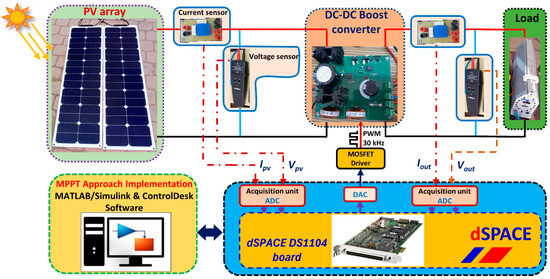
Figure 2.
Comprehensive overview of the proposed photovoltaic system.
- This study presents a newly improved variable-step current perturbation Perturb and Observe (IVSCP-PO) MPPT controller strategy.
- It provides a dynamic adjustment of step size based on simultaneous changes in power, voltage, and current for precise tuning and faster convergence.
- It incorporates a drift avoidance mechanism to prevent loss of tracking locus during rapid changes in atmospheric conditions, enhancing accuracy and stability.
- It effectively tracks the MPP under sudden changes in insolation conditions, overcoming the limitations of traditional and improved PO algorithms.
- Extensive comparison with the traditional PO approach under various scenarios demonstrates superior performance in convergence speed, MPP fluctuation, accuracy, and tracking efficiency.
- It is experimentally validated using a real-time test bench system with the dSPACE DS1104 board, providing practical evidence of the approach’s effectiveness beyond simulations.
The rest of the paper is structured as follows: An overview of the components of the photovoltaic system, including the mathematical model of solar photovoltaic cell equivalent circuit, and the maximum power point system is given in Section 2. Section 3 discusses the results achieved under simulation and experimental investigations. Section 4 offers the conclusions of this study.
2. An Overview of the Components of the Photovoltaic System
2.1. Mathematical Model of Solar Photovoltaic Cell Equivalent Circuit
Modeling a solar photovoltaic cell is essential to predict the behavior of a physical solar photovoltaic cell under different environmental circumstances and subsequently generate its characteristic waveforms of current versus voltage (I-V) and power versus voltage (P-V) [41]. Furthermore, the modeling step is crucial to evaluate the impact of different model parameters on the operation of solar photovoltaic cells [41]. Typically, a solar photovoltaic cell is denoted by an equivalent electrical circuit composed of a light-generated current source; one, two, or three antiparallel diodes; an internal series; and parallel resistances ((Rs) and (Rp)) [42,43]. Figure 3 shows the common electrical circuit models of a solar cell that have been proposed in the scientific literature, including ideal, single-diode, two-diode, and three-diode models [42].
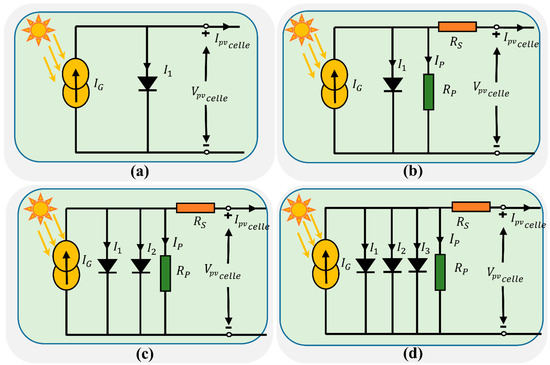
Figure 3.
Electrical circuit of the equivalent model of a solar photovoltaic cell: (a) ideal, (b) one diode, (c) two diodes, and (d) three diodes.
The ideal model is simple but inaccurate; the single-diode model balances complexity and accuracy; the two-diode model offers higher accuracy by capturing recombination effects; the three-diode model provides the highest accuracy with the most complexity and parameterization challenges [44].
However, the on-diode model, which can also be called the five-parameter (5-p) model, as depicted in Figure 3b, is the most used and well known among all models, due to its simplicity and accuracy compared with its counterparts [45].
The relationship between the photovoltaic cell current and voltage of the equivalent circuit models mentioned above, such as ideal, single-diode, two-diode and three-diode, can be expressed by the following Equations (1), (2), (3), and (4), respectively, as [46,47]:
where the photo-generated current (IG), the reverse saturation current (Isj), and the thermal voltage (Vtj) can be expressed, respectively, by the following Equations (5)–(7).
The electrical equivalent circuit of a typical photovoltaic generator can be obtained by the arrangement of series and parallel branches as described in Figure 4, and the mathematical expression of its output current using a single-diode model can be expressed by Equation (8) as follows [47,48]:
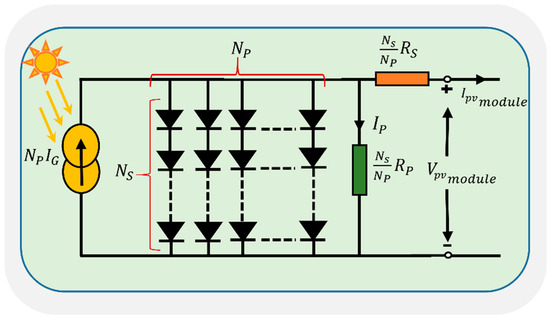
Figure 4.
Electrical circuit of the equivalent photovoltaic module in series and parallel branches.
2.2. Maximum Power Point System
2.2.1. DC-DC Converter
To have suitable and reliable photovoltaic energy exploitation and to attain high energy conversion, Direct Current to Direct Current (DC-DC) converters are an essential key. Indeed, the implementation of the MPPT mechanism is not feasible without the use of DC-DC converters. For such purposes, they are used as an interface between incompatible components (photovoltaic array and loads (DC charge or batteries) in this case) to achieve the optimum available power transfer from photovoltaic panels to loads [49].
There are many structures or topologies of DC-DC converters that can be used in photovoltaic system applications, such as buck, boost, buck-boost, Single-Ended Primary Inductance Converter (SEPIC), forward, Flyback, Push–Pull, and others, as reported in [50]. The boost or step-up converter shown in Figure 5 has been the most commonly used among other converters in various applications of photovoltaic systems with a wide range of power levels, from milliwatts (mW) to gigawatts (GW) [51]; this is due to its simple circuits and good efficiency.
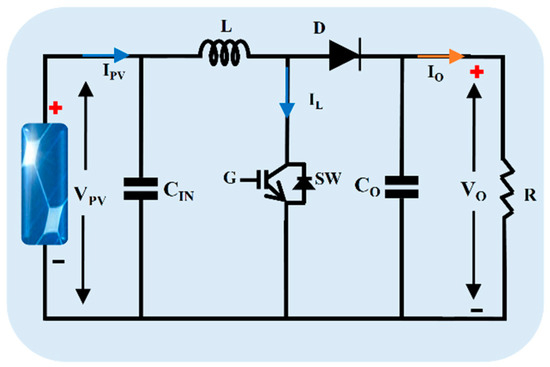
Figure 5.
The boost converter schematic circuit.
As shown in Figure 6, the boost converter can operate in two-time states according to the status of the switch (SW), which can be enabled (on) or disabled (off).

Figure 6.
Operating time states of the boost converter: (a) on and (b) off.
If the inductor current IL of the DC-DC boost converter returns to zero during each switching period, the boost converter in this situation works in Discontinuous Conduction Mode (DCM). On the contrary, the boost converter works in Continuous Conduction Mode (CCM), and the inductor current IL is always greater than zero. To operate the boost converter in the CCM, the minimum value of the inductor () can be calculated using the following Equation (9) [52]:
To obtain a minimum ripple in the input and output voltages of the boost converter, the filter capacitors must be carefully designed and calculated according to Equations (10) and (11) [52]:
where D, F, and R present, respectively, the duty ratio of the converter, the switching frequency, and the load. The relationships of the conversion ratio of the DC-DC step-up converter between the input and output sides in the case of voltage and current are revealed in Equations (12) and (13).
2.2.2. Classical and Amended PO MPPT Controllers
- (a)
- Classical PO MPPT algorithm
Among the countless MPPT controllers suggested in the literature, the PO scheme has been extensively used to follow the optimal available power of the solar photovoltaic panel [53,54,55,56]. In the PO approach, as presented by its flowchart in Figure 7a, a perturbation process is used to track the MPP of the photovoltaic system by perturbing the operating point of the photovoltaic panel and observing the effect on the power output. The perturbation in the PO can be either based on voltage or current, but the voltage perturbation is the most commonly employed [57]. As declared by [58], the perturbation-based current has some advantages, such as fast tracking and fewer oscillations. For this reason, in this paper, the perturbation-based current is considered.
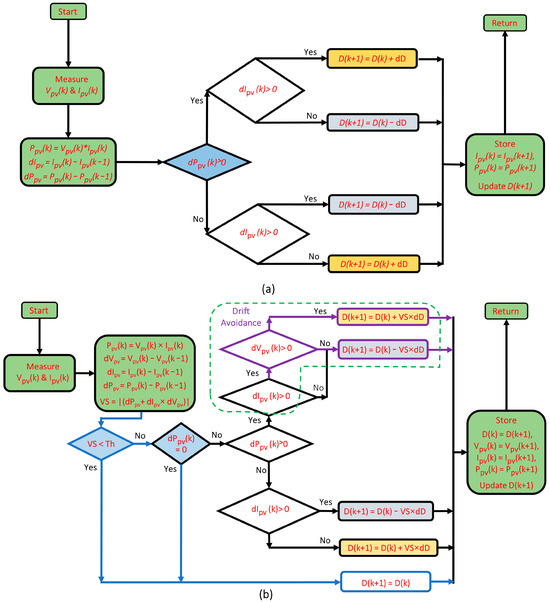
Figure 7.
Flowchart of the MPPT controllers; (a) PO and (b) proposed IVSCP-PO.
On the other hand, in addition to the oscillation, slow converging speed, and power-loss problems, the PO method can present worse tracking performance due to the fixed perturbation step size, especially during sudden variations in insolation levels. In some cases, the PO method can lose the tracking locus and drift away from the real maximum power point (MPP). This issue is commonly referred to as the “drift problem”.
- (b)
- Proposed IVSCP-PO MPPT controller
In this context, in this study, an improved perturbation-based current IVSCP-PO controller is proposed to deal with the aforementioned disadvantages of the classical PO controller and to enhance its tracking performance under various weather circumstances.
This enhanced approach introduces several key modifications. First, instead of perturbing the PV voltage, the proposed method perturbs the PV current, which is a parameter that is more commonly used in MPPT algorithms. Additionally, the IVSCP-PO algorithm incorporates an adjustable step amplitude, as opposed to a fixed value, during the perturbation process.
To overcome the drift problem encountered in the traditional PO method, the proposed algorithm utilizes a mechanism that continuously monitors the voltage and current of PV. This monitoring mechanism enables the algorithm to detect and correct any deviation from the optimal tracking direction. By addressing this issue, the IVSCP-PO strategy effectively mitigates the tracking loss direction problem, which is a major drawback of the conventional PO method.
The IVSCP-PO controller employs a variable amplitude in the perturbation step to quickly adjust the duty ratio. This can be achieved by using a new variable step (VS.), which is illustrated in Figure 8. The VS. value is determined based on the absolute (abs) value of the change in power (), voltage (), and current () of the PV array, as expressed by Equation (14). As can be shown in the graph in Figure 8, the VS. value is big outside of the MPP region, which helps it to reach the MPP quickly, and is almost small when the MPP is reached, which means that lower oscillations around the MPP are insured. It is worth noting that the threshold value (Th), set to 0.003 in this study, was selected to better locate the MPP.
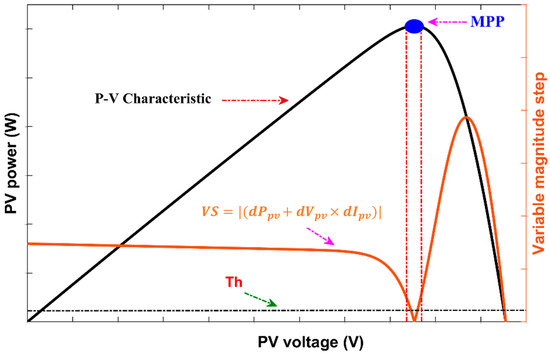
Figure 8.
Pictorial representation of the suggested variable magnitude of the iteration step in view of P-V and I-V curves.
Thus, the duty ratio of the IVSCP-PO controller can be automatically adjusted and generated using Equation (15).
where dD is a perturbation constant, as used in the classical PO approach. Figure 7b shows the flowcharts of the proposed IVSCP-PO controller.
3. Results and Discussions
3.1. Simulation-Based Investigation
In order to investigate the accuracy of the IVSCP-PO approach, simulations based on the MATLAB/Simulink tool (R2018a) were carried out under various climatic conditions of temperature and solar intensity. In addition, a comparison with the traditional PO controller was performed to show the effectiveness and benefits of the improved controller over its counterpart.
The entire components of the solar photovoltaic system are illustrated in Figure 9. and their parameters are depicted in Table 1. The system consists of three main parts: the source, interface, and charge parts. The source part contains a photovoltaic generator (module/array), the interface part contains an MPPT algorithm, a DC-DC boost converter and a PWM generator, and the charge part contains a resistive load. In addition, two sensors are used for current and voltage measurement, and a powergui environment block is used for the Simscape Power Systems Specialized Technology model simulation.
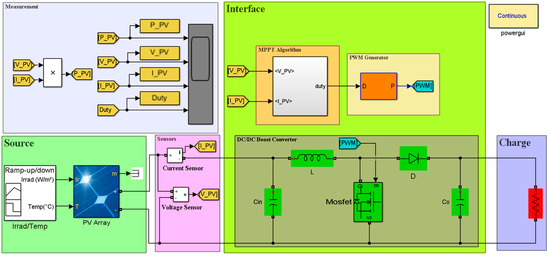
Figure 9.
The overall standalone solar photovoltaic system model in the MATLAB/Simulink environment.

Table 1.
Parameters of the photovoltaic system.
The efficiency of tracking is the ratio of the power extracted by the MPPT controller to the maximum available power of the photovoltaic panel. Accordingly, it can be mathematically expressed by Equation (16) as follows:
3.1.1. Variable Atmospheric Circumstances
The atmospheric circumstances adopted in this simulation investigation are rapid variations in solar intensity and temperature. In the first investigation, the solar intensity abruptly varies between four levels in the following order: 500 W/m2 to 1000 W/m2 to 600 W/m2 to 900 W/m2 to 600 W/m2 to 1000 W/m2 to 500 W/m2, assuming a fixed temperature of 25 °C. In the second investigation, the solar intensity is taken to be constant at 1000 W/m2, while the temperature suddenly varies as follows: 25 °C to 50 °C to 35 °C to 45 °C to 35 °C to 50 °C to 25 °C.
First Investigation during the Rapid Shift in Solar Intensity
The results achieved from the first investigation, which involved an abrupt shift in solar intensity, are revealed in Figure 10, Figure 11 and Figure 12.
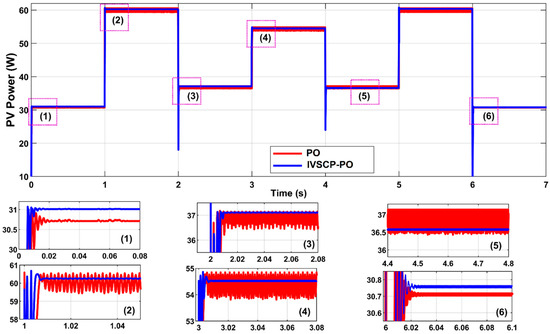
Figure 10.
Plots of the photovoltaic power of the PO and IVSCP-PO controllers in the case of the rapid solar intensity shift with zoomed-in view captions.

Figure 11.
Plots of the duty ratio, photovoltaic current, and voltage of the PO and IVSCP-PO controllers in the case of the rapid solar intensity shift.
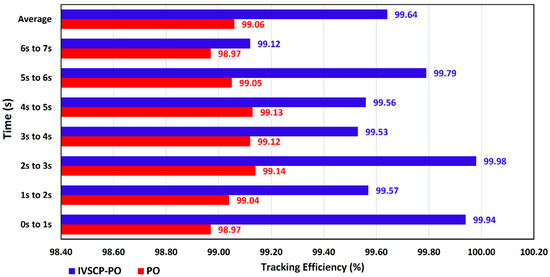
Figure 12.
Efficiency of tracking of the PO and IVSCP-PO controllers in the case of the rapid solar intensity shift.
The plots of photovoltaic power versus time are shown in Figure 10, while Figure 11 presents the plots of duty ratio, photovoltaic current, and voltage versus time. As can be seen from Figure 10, the IVSCP-PO controller can provide robust tracking over the PO method during the entire simulation time, particularly during abrupt changes in solar intensity. It demonstrates better performance in terms of improving the converging velocity, reducing tracking time, and avoiding the ripple and loss of tracking direction problems that PO suffers from, as clearly shown from the zoomed-in views of Figure 10. The same performance can also be seen from the duty ratio, photovoltaic current, and voltage plots in Figure 11. Based on these results, the IVSCP-PO controller can markedly enhance tracking efficiency throughout the entire simulation time, as demonstrated in Figure 12, where it achieves 99.98% as the highest value of static efficiency of tracking over 99.14% of the PO method and provides 99.64% as dynamic tracking efficiency (average) compared to 99.06% of its counterpart.
Second Investigation under Rapid Shift in Temperature
The outcomes of the second investigation, which involved a sudden temperature shift, have been disclosed in Figure 13, Figure 14 and Figure 15. Figure 13 depicts the photovoltaic power plots against time, while Figure 14 displays the plots of the duty ratio, photovoltaic current, and voltage plots against time. The IVSCP-PO scheme has proven to provide robust tracking during all simulation periods, especially during abrupt temperature shifts, as revealed in Figure 13. It can display better performance by enhancing converging velocity, reducing tracking time, and preventing undulation and loss of tracking direction problems, which are typical issues associated with the PO method. These findings are evident, as the zoomed captions of Figure 13 illustrate. Similar performance can be perceived from the duty ratio, photovoltaic current, and voltage plots in Figure 14. According to these outcomes and as demonstrated in Figure 15, the IVSCP-PO scheme can evidently enhance tracking efficiency, achieving an utmost static efficiency of 99.99% with an average (dynamic) of 99.98% over 99.24% as static efficiency and 99.17% as dynamic tracking efficiency of the PO method.

Figure 13.
Plots of the photovoltaic power of the PO and IVSCP-PO controllers in the case of the rapid temperature shift with zoomed-in view captions.
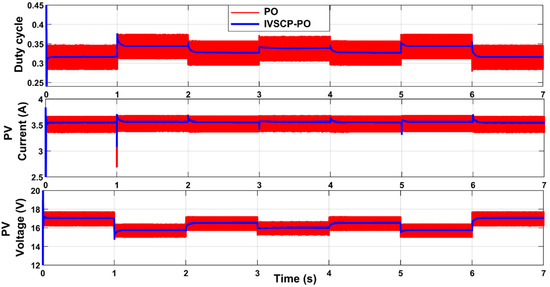
Figure 14.
Plots of the duty ratio, photovoltaic current, and voltage of the PO and IVSCP-PO controllers across the quick temperature shift.
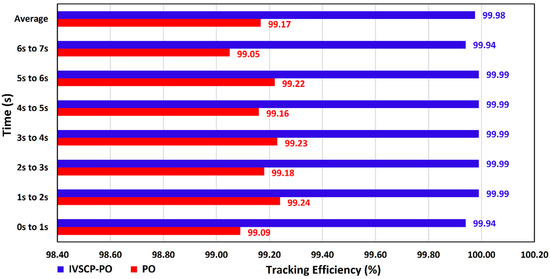
Figure 15.
Efficiency of tracking of the PO and IVSCP-PO controllers across fast temperature change.
Third Investigation under Gradient Insolation Situations
The results obtained for the photovoltaic power using the IVSCP-PO and PO strategies during the gradient variations in insolation, as shown in Figure 16, are depicted in Figure 17. Based on the results achieved, it is noteworthy that the IVSCP-PO scheme presented better following of the optimum power throughout the simulation time compared with the PO tactic. According to the numerated captions of Figure 17, it is noteworthy that the IVSCP-PO strategy successfully avoids the ripple and drift problems, especially during severe insolation variations. On the contrary, the conventional PO approach exhibits inferior tracking capabilities as a result of pronounced ripples and the deviation of the tracking locus from the actual MPP. Such ripples can lead to a displacement of the tracking locus from the genuine MPP, thereby resulting in a decline in power output. This phenomenon is readily discernible in the magnified sections presented in Figure 17.

Figure 16.
Ramp-up/down solar intensities profile.

Figure 17.
Photovoltaic power tracking waveforms under ramp-up/down solar intensities profile.
Table 2 presents a comparative analysis of the performance of the proposed IVSCP-PO MPPT technique against other MPPT approaches reported in the literature. Several key parameters are evaluated, including the year of publication, converter type, average tracking time, converging velocity, average efficiency of tracking, output fluctuations, implementation complexity, and the availability of experimental verification. The data show that the proposed IVSCP-PO controller outperforms the other MPPT techniques in several aspects. It achieves the fastest average tracking time of 0.002 s, indicating a very high converging velocity. This is a significant improvement compared to the other methods, which range from 0.036 to 0.6 s. The IVSCP-PO also exhibits the highest average efficiency of tracking at 99.85%, surpassing the other approaches, which have efficiencies ranging from 96% to 99.6%. Notably, the IVSCP-PO is the only technique reported to achieve zero output fluctuations, further enhancing the power quality and stability of the system. In terms of implementation complexity, the IVSCP-PO is classified as low, on par with some of the other simpler MPPT methods. This is an important consideration for industrial applications, where computational burden and ease of implementation are crucial factors. Lastly, the IVSCP-PO approach has been experimentally verified, providing a stronger validation of its performance compared to some of the other methods that only present simulation results.

Table 2.
The average performance analysis of the IVSCP-PO tactic in relation to other MPPT techniques reported in published studies.
3.2. Experimental-Based Investigation
To assess the practical performance of the newly proposed MPPT strategy, an experimental prototype of an off-grid photovoltaic system was developed and depicted in Figure 18. The off-grid photovoltaic system comprises a photovoltaic array that generates a DC charge through a DC-DC boost converter and is equipped with a dSPACE DS1104 platform (manufactured by dSPACE GmbH, Paderborn, Germany) interface for MPPT implementation. Current and voltage measurements were conducted using the LA 25-NP sensor (manufactured by LEM, Geneva, Switzerland) and the MX 9030 sensor (manufactured by Chauvin Arnoux, France), respectively. Additionally, a Kipp and Zonen pyranometer (manufactured in Delft, The Netherlands), with a sensitivity of 14.69 × 10−3 mV, was employed to measure solar irradiance. Additionally, the temperature was measured using a silicon diode with a PN junction. It must be noted that the specifications of the photovoltaic array and boost converter that have been used in the experimental validation are tabulated in Table 3.
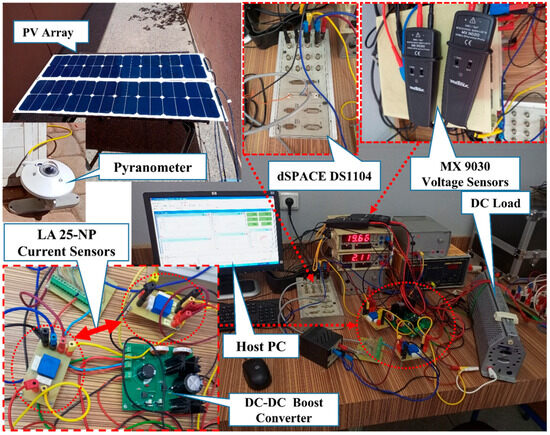
Figure 18.
The implemented configuration of the standalone photovoltaic system for experimentation.

Table 3.
Experimental parameters of the sub-components of the converter and PV module.
3.2.1. Static Atmospheric Circumstances
The practical results of the classical and improved PO controllers determined from static weather circumstances are shown in in Figure 19. It is important to mention that these experimental results were obtained under stable conditions in Marrakech on 08 August 2022, where the solar intensity and the surrounding temperature conditions were approximately 894 W/m2 and 29.5 °C, respectively.
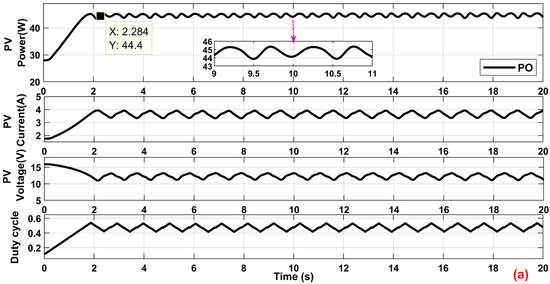
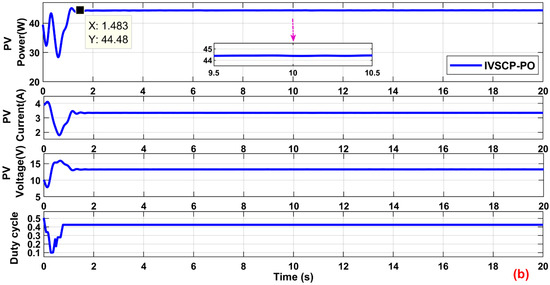
Figure 19.
Plots of the photovoltaic power, current, voltage and duty ratio in stable situations: (a) PO and (b) IVSCP-PO.
The tracking curves of the photovoltaic power, current, voltage, and duty ratio of the PO and IVSCP-PO approaches are illustrated, respectively, in Figure 19a,b.
As can be clearly seen from the photovoltaic power tracking curves, both controllers succeeded in tracking the MPP; however, the PO shows a long tracking time (2.284 s) with noticeable fluctuations, which leads to great losses of power and, thus, low efficiency. On the other hand, the IVSCP-PO controller provides a faster tracking time (1.483 s) with zero fluctuation, leading to marked mitigation of power loss; therefore, high tracking efficiency is guaranteed.
3.2.2. Variable Atmospheric Circumstances
The practical results acquired for both MPPT controllers under variable climatic circumstances are depicted in Figure 20. It is worth mentioning that these experimental results were achieved during the rapid shift of insolation conditions in Marrakech on 12 August 2022, where the solar intensity suddenly shifted between 836 W/m2 and 418 W/m2 and the ambient temperature was fixed at 37.1 °C.

Figure 20.
Plots of the photovoltaic power, current, voltage and duty ratio during variable situations: (a) PO and (b) IVSCP-PO.
In light of the experimental tracking waveforms of the photovoltaic power, voltage, current, and duty ratio of the PO and IVSCP-PO controllers, it is noteworthy that the IVSCP-PO ensures robust tracking of the real MPP with the fastest converging velocity despite the abrupt shift in the solar intensity and with neglected steady-state fluctuation, as is evidenced by its tracking curves in Figure 20b. On the contrary, the PO shows poor following of the MPP, especially during the abrupt shift of the insolation, where it drifts away from the real MPP and loses its tracking locus in the range time between 5.8 s and 14.61 s, in addition to the noticeable fluctuation problem that is shown from its tracking waveforms in Figure 20a.
4. Conclusions
Solar panels rely on MPPT controllers to continuously find the optimal operating point for maximum power generation. Traditional PO methods often suffer from slow convergence speeds and significant output fluctuations, resulting in considerable power loss. The proposed IVSCP-PO controller tackles these limitations by utilizing a variable step size to automatically adjust the duty cycle. This innovative approach achieves significantly faster convergence compared to traditional methods, translating to minimized energy losses during rapid weather changes. Comprehensive simulations and experimental validation using the dSPACE 1104 board confirm the superior performance of the IVSCP-PO approach.
The controller boasts a record-breaking average tracking time of just 0.002 s, a substantial improvement over traditional improved PO methods (0.036 to 0.6 s). Additionally, it achieves the highest average tracking efficiency of 99.85%, surpassing even recently published traditional P&O algorithms (96% to 99.6%).
Our findings offer a promising solution for optimizing photovoltaic panel performance under real-world conditions, with potential applications across various industries, maximizing the efficiency and profitability of solar energy systems. However, while the IVSCP-PO controller demonstrates promising results in hardware conditions, its real-field applicability and comparison to existing practices still need further investigation.
A critical assessment of field effectiveness and real-time practical impacts is essential. Future work could explore merging the proposed IVSCP-PO with metaheuristic methods to enhance its tracking performance further, especially under Partial Shading Conditions (PSC). Additionally, long-term field studies and real-world deployment will be crucial to validate the controller’s practical utility and integration into existing solar energy systems.
Author Contributions
A.C. contributed to the conceptualization, methodology, software, validation, formal analysis, investigation, resources, data curation, writing—original draft preparation, and writing—review and editing. S.E.B. contributed to the visualization, supervision and validation. All authors have read and agreed to the published version of the manuscript.
Funding
This research received no external funding.
Data Availability Statement
The original contributions presented in the study are included in the article, further inquiries can be directed to the corresponding author.
Conflicts of Interest
The authors declare no conflicts of interest.
References
- Guo, Y.; Wang, H.; Lian, J. Review of integrated installation technologies for offshore wind turbines: Current progress and future development trends. Energy Convers. Manag. 2022, 255, 115319. [Google Scholar] [CrossRef]
- Bouabdalli, E.M.; Jouad, M.; Touhtouh, S.; Chellakhi, A.; Hajjaji, A. Synthesis, structural, and optical behavior of erbium-doped silicophosphate glasses for photonics applications. Luminescence 2024, 39, e4802. [Google Scholar] [CrossRef]
- Ahmadi, S.; Tostado-Véliz, M.; Ghadimi, A.A.; Miveh, M.R.; Jurado, F. A novel interval-based formulation for optimal scheduling of microgrids with pumped-hydro and battery energy storage under uncertainty. Int. J. Energy Res. 2022, 46, 12854–12870. [Google Scholar] [CrossRef]
- Mouncef, E.M.; Mostafa, B. Battery total capacity estimation based on the sunflower algorithm. J. Energy Storage 2022, 48, 103900. [Google Scholar] [CrossRef]
- Hsu, R.Y.; Lai, Y.L.; Chou, Y.H.; Syu, W.J. Improving Carrier Transport Behavior in a Bilayer ETL for Enhanced Efficiency of Perovskite Solar Cells: An Investigation. Energies 2024, 17, 871. [Google Scholar] [CrossRef]
- Zhang, Y.; Zhou, L.; Zhang, C. Research Progress of Semi-Transparent Perovskite and Four-Terminal Perovskite/Silicon Tandem Solar Cells. Energies 2024, 17, 1833. [Google Scholar] [CrossRef]
- Fatima, Q.; Haidry, A.A.; Hussain, R.; Zhang, H. Device Simulation of a Thin-Layer CsSnI3-Based Solar Cell with Enhanced 31.09% Efficiency. Energy Fuels 2023, 37, 7411–7423. [Google Scholar] [CrossRef]
- Huda, A.; Kurniawan, I.; Purba, K.F.; Ichwani, R.; Aryansyah; Fionasari, R. Techno-economic assessment of residential and farm-based photovoltaic systems. Renew. Energy 2024, 222, 119886. [Google Scholar] [CrossRef]
- El Kassar, R.; Al Takash, A.; Faraj, J.; Khaled, M.; Ramadan, H.S. Phase change materials for enhanced photovoltaic panels performance: A comprehensive review and critical analysis. Energy Built Environ. 2024. [Google Scholar] [CrossRef]
- Bouabdalli, E.M.; El Jouad, M.; Garmim, T.; Louardi, A.; Hartiti, B.; Monkade, M.; Touhtouh, S.; Hajjaji, A. Elaboration and characterization of Ni and Al co-doped SnO2 thin films prepared by spray pyrolysis technique for photovoltaic applications. Mater. Sci. Eng. B 2022, 286, 116044. [Google Scholar] [CrossRef]
- Chellakhi, A.; El Beid, S.; Abouelmahjoub, Y.; Mchaouar, Y. Optimization of Power Extracting from Photovoltaic Systems Based on a Novel Adaptable Step INC MPPT Approach. IFAC-PapersOnLine 2022, 55, 508–513. [Google Scholar] [CrossRef]
- Katche, M.L.; Makokha, A.B.; Zachary, S.O.; Adaramola, M.S. A Comprehensive Review of Maximum Power Point Tracking (MPPT) Techniques Used in Solar PV Systems. Energies 2023, 16, 2206. [Google Scholar] [CrossRef]
- Farahani, M.; Shamsi-nejad, M.A.; Najafi, H.R. Design and construction of a digital solar array simulator with fast dynamics and high performance. Sol. Energy 2020, 196, 319–326. [Google Scholar] [CrossRef]
- Chellakhi, A.; El Beid, S.; Abouelmahjoub, Y. An Improved Maximum Power Point Approach for Temperature Variation in PV System Applications. Int. J. Photoenergy 2021, 2021, 9973204. [Google Scholar] [CrossRef]
- Yang, B.; Zhu, T.; Wang, J.; Shu, H.; Yu, T.; Zhang, X.; Yao, W.; Sun, L. Comprehensive overview of maximum power point tracking algorithms of PV systems under partial shading condition. J. Clean. Prod. 2020, 268, 121983. [Google Scholar] [CrossRef]
- Nguimfack-Ndongmo, J.D.D.; Harrison, A.; Alombah, N.H.; Kuate-Fochie, R.; Asoh, D.A.; Kenné, G. Adaptive terminal synergetic-backstepping technique based machine learning regression algorithm for MPPT control of PV systems under real climatic conditions. ISA Trans. 2024, 145, 423–442. [Google Scholar] [CrossRef] [PubMed]
- Boubaker, O. MPPT techniques for photovoltaic systems: A systematic review in current trends and recent advances in artificial intelligence. Discov. Energy 2023, 3, 9. [Google Scholar] [CrossRef]
- Harrison, A.; Nfah, E.M.; De Dieu Nguimfack Ndongmo, J.; Alombah, N.H. An Enhanced P&O MPPT Algorithm for PV Systems with Fast Dynamic and Steady-State Response under Real Irradiance and Temperature Conditions. Int. J. Photoenergy 2022, 2022, 6009632. [Google Scholar] [CrossRef]
- Sameera; Tariq, M.; Rihan, M.; Ayan, M. A comprehensive review on the application of recently introduced optimization techniques obtaining maximum power in the solar PV System. Renew. Energy Focus 2024, 49, 100564. [Google Scholar] [CrossRef]
- Jately, V.; Azzopardi, B.; Joshi, J.; Venkateswaran, V.B.; Sharma, A.; Arora, S. Experimental Analysis of hill-climbing MPPT algorithms under low irradiance levels. Renew. Sustain. Energy Rev. 2021, 150, 111467. [Google Scholar] [CrossRef]
- Chellakhi, A.; El Beid, S.; Abouelmahjoub, Y. An Innovative Fast-Converging Speed MPPT Approach without Oscillation for Temperature Varying in Photovoltaic Systems Applications. Energy Sources Part A Recover. Util. Environ. Eff. 2022, 44, 2674–2696. [Google Scholar] [CrossRef]
- Behera, P.K.; Pattnaik, M. Design and real-time implementation of wind–photovoltaic driven low voltage direct current microgrid integrated with hybrid energy storage system. J. Power Sources 2024, 595, 234028. [Google Scholar] [CrossRef]
- Chellakhi, A.; El Beid, S.; Abouelmahjoub, Y.; Doubabi, H. An Enhanced Incremental Conductance MPPT Approach for PV Power Optimization: A Simulation and Experimental Study. Arab. J. Sci. Eng. 2024. [Google Scholar] [CrossRef]
- Ali, M.N.; Mahmoud, K.; Lehtonen, M.; Darwish, M.M.F. An Efficient Fuzzy-Logic Based Variable-Step Incremental Conductance MPPT Method for Grid-Connected PV Systems. IEEE Access 2021, 9, 26420–26430. [Google Scholar] [CrossRef]
- Fapi, C.B.N.; Wira, P.; Kamta, M.; Tchakounté, H.; Colicchio, B. Simulation and dSPACE Hardware Implementation of an Improved Fractional Short-Circuit Current MPPT Algorithm for Photovoltaic System. Appl. Sol. Energy (Engl. Transl. Geliotekhnika) 2021, 57, 93–106. [Google Scholar] [CrossRef]
- Bollipo, R.B.; Mikkili, S.; Bonthagorla, P.K. Hybrid, Optimization, Intelligent and Classical PV MPPT Techniques: Review. CSEE J. Power Energy Syst. 2020, 7, 9–33. [Google Scholar]
- Abidi, H.; Sidhom, L.; Chihi, I. Systematic Literature Review and Benchmarking for Photovoltaic MPPT Techniques. Energies 2023, 16, 3509. [Google Scholar] [CrossRef]
- Ibrahim, M.H.; Ang, S.P.; Dani, M.N.; Rahman, M.I.; Petra, R.; Sulthan, S.M. Optimizing Step-Size of Perturb & Observe and Incremental Conductance MPPT Techniques Using PSO for Grid-Tied PV System. IEEE Access 2023, 11, 13079–13090. [Google Scholar] [CrossRef]
- Guerra, M.I.S.; de Araújo, F.M.U.; Dhimish, M.; Vieira, R.G. Assessing maximum power point tracking intelligent techniques on a pv system with a buck–boost converter. Energies 2021, 14, 7453. [Google Scholar] [CrossRef]
- Jamshidi, F.; Salehizadeh, M.R.; Yazdani, R.; Azzopardi, B.; Jately, V. An Improved Sliding Mode Controller for MPP Tracking of Photovoltaics. Energies 2023, 16, 2473. [Google Scholar] [CrossRef]
- Baatiah, A.O.; Eltamaly, A.M.; Alotaibi, M.A. Improving Photovoltaic MPPT Performance through PSO Dynamic Swarm Size Reduction. Energies 2023, 16, 6433. [Google Scholar] [CrossRef]
- Chao, K.H.; Rizal, M.N. A hybrid mppt controller based on the genetic algorithm and ant colony optimization for photovoltaic systems under partially shaded conditions. Energies 2021, 14, 2902. [Google Scholar] [CrossRef]
- Gong, L.; Hou, G.; Huang, C. A two-stage MPPT controller for PV system based on the improved artificial bee colony and simultaneous heat transfer search algorithm. ISA Trans. 2023, 132, 428–443. [Google Scholar] [CrossRef]
- Aguila-Leon, J.; Vargas-Salgado, C.; Chiñas-Palacios, C.; Díaz-Bello, D. Solar photovoltaic Maximum Power Point Tracking controller optimization using Grey Wolf Optimizer: A performance comparison between bio-inspired and traditional algorithms. Expert Syst. Appl. 2023, 211, 118700. [Google Scholar] [CrossRef]
- Raj, R.D.A.; Naik, K.A. Priority queue-based switching matrix algorithm for adaptive neuro-fuzzy inference system assisted MPPT controlled PV system. Energy Convers. Manag. 2023, 293, 117519. [Google Scholar] [CrossRef]
- Liu, H.; Khan, M.Y.A.; Yuan, X. Hybrid Maximum Power Extraction Methods for Photovoltaic Systems: A Comprehensive Review. Energies 2023, 16, 5665. [Google Scholar] [CrossRef]
- Mohanty, S.; Subudhi, B.; Ray, P.K. A Grey Wolf-Assisted Perturb & Observe MPPT Algorithm for a PV System. IEEE Trans. Energy Convers. 2017, 32, 340–347. [Google Scholar] [CrossRef]
- Harrison, A.; Dieu Nguimfack-Ndongmo, J.D.; Alombah, N.H.; Aloyem Kazé, C.V.; Kuate-Fochie, R.; Asoh, D.A.; Nfah, E.M. Robust nonlinear MPPT controller for PV energy systems using PSO-based integral backstepping and artificial neural network techniques. Int. J. Dyn. Control 2023, 12, 1598–1615. [Google Scholar] [CrossRef]
- Ajiatmo, D.; Robandi, I. A Hybrid fuzzy logic controller-firefly algorithm (FLC-FA) based for MPPT photovoltaic (PV) system in solar car. In Proceedings of the 2016 IEEE International Conference on Power and Renewable Energy, ICPRE, Shanghai, China, 21–23 October 2016. [Google Scholar] [CrossRef]
- Padmanaban, S.; Priyadarshi, N.; Bhaskar, M.S.; Holm-Nielsen, J.B.; Ramachandaramurthy, V.K.; Hossain, E. A Hybrid ANFIS-ABC Based MPPT Controller for PV System with Anti-Islanding Grid Protection: Experimental Realization. IEEE Access 2019, 7, 103377–103389. [Google Scholar] [CrossRef]
- El Marghichi, M.; Dangoury, S. Electrical parameters identification for three diode photovoltaic based on the manta ray foraging optimization with dynamic fitness distance balance. Optik 2024, 296, 171548. [Google Scholar] [CrossRef]
- Magableh, M.A.K.; Radwan, A.; Mohamed, Y.A.R.I. A Novel Hybrid Approach Based on Analytical and Metaheuristic Algorithms for Parameters and Dynamic Resistance Estimation of a PV Array. IEEE Trans. Power Syst. 2023, 38, 5459–5474. [Google Scholar] [CrossRef]
- Mouncef, E.; Hilali, A.; Loulijat, A.; Essounaini, A.; Chellakhi, A. Modelling photovoltaic modules with enhanced accuracy using particle swarm clustered optimization. Acta IMEKO 2024, 13, 1–10. [Google Scholar] [CrossRef]
- Changmai, P.; Deka, S.; Kumar, S.; Babu, T.S.; Aljafari, B.; Nastasi, B. A Critical Review on the Estimation Techniques of the Solar PV Cell’s Unknown Parameters. Energies 2022, 15, 7212. [Google Scholar] [CrossRef]
- Castro, R.; Silva, M. Experimental and theoretical validation of one diode and three parameters–based pv models. Energies 2021, 14, 2140. [Google Scholar] [CrossRef]
- Chellakhi, A.; El Beid, S.; Abouelmahjoub, Y. A novel theta MPPT approach based on adjustable step size for photovoltaic system applications under various atmospheric conditions. Energy Syst. 2022, 15, 89–114. [Google Scholar] [CrossRef]
- Rai, N.; Abbadi, A.; Hamidia, F.; Douifi, N.; Samad, B.A.; Yahya, K. Biogeography-Based Teaching Learning-Based Optimization Algorithm for Identifying One-Diode, Two-Diode and Three-Diode Models of Photovoltaic Cell and Module. Mathematics 2023, 11, 1861. [Google Scholar] [CrossRef]
- Abdelkhalek, C.; Said, E.B.; Younes, A. A novel MPPT tactic for PV systems with fast-converging speed and zero oscillation. In Proceedings of the 2020 5th International Conference on Renewable Energies for Developing Countries, REDEC, Marrakech, Morocco, 29–30 June 2020. [Google Scholar] [CrossRef]
- Farajdadian, S.; Hajizadeh, A.; Soltani, M. Recent developments of multiport DC/DC converter topologies, control strategies, and applications: A comparative review and analysis. Energy Rep. 2024, 11, 1019–1052. [Google Scholar] [CrossRef]
- Nandish, B.M.; Pushparajesh, V.; Marulasiddappa, H.B. DC-DC power converter topologies for sustainable applications. In Power Converters, Drives and Controls for Sustainable Operations; John Wiley & Sons: Hoboken, NJ, USA, 2024. [Google Scholar] [CrossRef]
- Jana, S.; Kumar, N.; Mishra, R.; Sen, D.; Saha, T.K. Development and implementation of modified MPPT algorithm for boost converter-based PV system under input and load deviation. Int. Trans. Electr. Energy Syst. 2020, 30, e12190. [Google Scholar] [CrossRef]
- Rashid, M.H. Power Electronics: Circuits, Devices, and Applications; Prentice Hall: Hoboken, NJ, USA, 1993. [Google Scholar]
- Chellakhi, A.; El Beid, S.; Abouelmahjoub, Y. An improved adaptable step-size P&O MPPT approach for standalone photovoltaic systems with battery station. Simul. Model. Pract. Theory 2022, 121, 102655. [Google Scholar] [CrossRef]
- Altwallbah, N.M.M.; Radzi, M.A.M.; Azis, N.; Shafie, S.; Zainuri, M.A.A.M. New perturb and observe algorithm based on trapezoidal rule: Uniform and partial shading conditions. Energy Convers. Manag. 2022, 264, 115738. [Google Scholar] [CrossRef]
- Taibi, D.; Amieur, T.; Laamayad, T.; Sedraoui, M. Improvement of the Standard Perturb & Observe MPPT control strategy by the proposed Fuzzy Logic Mechanism for a Cascade Regulation of a PMSM-based PV pumping system. Arab. J. Sci. Eng. 2023, 48, 6631–6647. [Google Scholar] [CrossRef]
- Ali, A.I.M.; Mousa, H.H.H.; Ramadan, H.; Kamel, S. An Enhanced P & O MPPT Algorithm With Concise Search Area for Grid-Tied PV Systems. IEEE Access 2023, 11, 79408–79421. [Google Scholar] [CrossRef]
- Kermadi, M.; Mekhilef, S.; Salam, Z.; Ahmed, J.; Berkouk, E.M. Assessment of maximum power point trackers performance using direct and indirect control methods. Int. Trans. Electr. Energy Syst. 2020, 30, e12565. [Google Scholar] [CrossRef]
- Kollimalla, S.K.; Mishra, M.K. A novel adaptive p&o mppt algorithm considering sudden changes in the irradiance. IEEE Trans. Energy Convers. 2014, 29, 602–610. [Google Scholar] [CrossRef]
- Wang, S.C.; Pai, H.Y.; Chen, G.J.; Liu, Y.H. A Fast and Efficient Maximum Power Tracking Combining Simplified State Estimation with Adaptive Perturb and Observe. IEEE Access 2020, 8, 155319–155328. [Google Scholar] [CrossRef]
- Mohammadinodoushan, M.; Abbassi, R.; Jerbi, H.; Ahmed, F.W.; Abdalqadir kh ahmed, H.; Rezvani, A. A new MPPT design using variable step size perturb and observe method for PV system under partially shaded conditions by modified shuffled frog leaping algorithm—SMC controller. Sustain. Energy Technol. Assess. 2021, 45, 101056. [Google Scholar] [CrossRef]
- Ahmed, J.; Salam, Z. A Modified P and O Maximum Power Point Tracking Method with Reduced Steady-State Oscillation and Improved Tracking Efficiency. IEEE Trans. Sustain. Energy 2016, 7, 1506–1515. [Google Scholar] [CrossRef]
- Femia, N.; Petrone, G.; Spagnuolo, G.; Vitelli, M. Optimization of perturb and observe maximum power point tracking method. IEEE Trans. Power Electron. 2005, 20, 963–973. [Google Scholar] [CrossRef]
- Manjunath, M.G.; Vyjayanthi, C.; Modi, C.N. Adaptive step size based drift-free P&O algorithm with power optimiser and load protection for maximum power extraction from PV panels in stand-alone applications. IET Renew. Power Gener. 2021, 15, 1270–1285. [Google Scholar] [CrossRef]
- Manoharan, P.; Subramaniam, U.; Babu, T.S.; Padmanaban, S.; Holm-Nielsen, J.B.; Mitolo, M.; Ravichandran, S. Improved Perturb and Observation Maximum Power Point Tracking Technique for Solar Photovoltaic Power Generation Systems. IEEE Syst. J. 2021, 15, 3024–3035. [Google Scholar] [CrossRef]
Disclaimer/Publisher’s Note: The statements, opinions and data contained in all publications are solely those of the individual author(s) and contributor(s) and not of MDPI and/or the editor(s). MDPI and/or the editor(s) disclaim responsibility for any injury to people or property resulting from any ideas, methods, instructions or products referred to in the content. |
© 2025 by the authors. Licensee MDPI, Basel, Switzerland. This article is an open access article distributed under the terms and conditions of the Creative Commons Attribution (CC BY) license (https://creativecommons.org/licenses/by/4.0/).